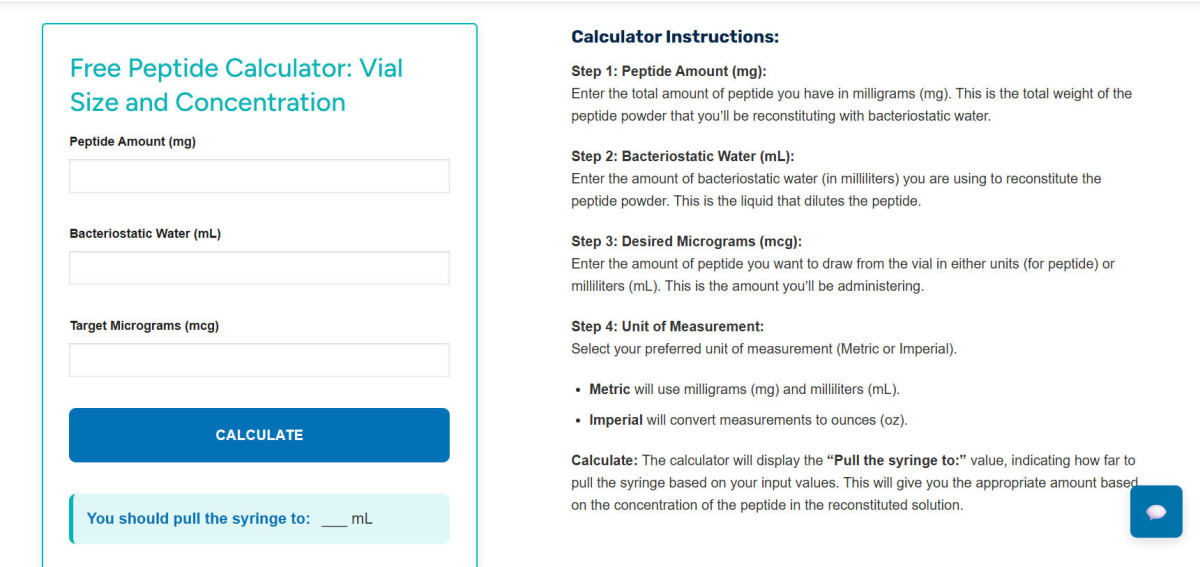Accurate calculation and reconstitution of peptide vials are essential for reproducible research workflows. This guide explains how to determine stock solution concentration, perform unit conversions, reconstitute peptides under sterile conditions, prepare working dilutions, store lyophilized and reconstituted peptides, and troubleshoot common solubility or aggregation issues.
Calculating Peptide Concentration
Peptide concentration is defined as mass divided by volume:
Concentration (mg/mL) = peptide mass (mg) ÷ diluent volume (mL)
To convert to micrograms per milliliter, multiply mg/mL by 1000. Molarity can be calculated using molecular weight:
Molarity (M) = (mg/mL ÷ molecular weight (g/mol)) × 1000
Unit conversions are important: 1 mg = 1000 mcg, and for U-100 insulin syringes, 1 mL = 100 IU. This allows translation of target microgram amounts into precise draw volumes.
Unit Conversion Example
A 5 mg/mL stock contains 5000 mcg/mL. To determine the required volume for 250 mcg:
Volume (mL) = 250 mcg ÷ 5000 mcg/mL = 0.05 mL
This mapping ensures accurate experimental measurements and consistent stock preparation.
Reconstitution Principles
Reconstitution involves dissolving lyophilized peptide in an appropriate diluent under sterile conditions. Solvent choice, gentle mixing, and immediate labeling are critical to prevent aggregation or degradation.
Common diluent options:
Bacteriostatic water: contains preservative for multi-use vials.
Sterile water: inert, suitable for single-use aliquots.
DMSO: dissolves hydrophobic peptides, to be diluted into aqueous buffer immediately.
Low percent acid: aids solubility of charged peptides.
Step-by-Step Reconstitution
Prepare a clean workspace and assemble syringes, diluent, labels, and personal protective equipment.
Sanitize the vial septum with an alcohol swab.
Draw the calculated volume of diluent into a sterile syringe.
Slowly inject along the vial wall to avoid foaming.
Gently swirl or flick until dissolved; avoid vigorous vortexing.
If incomplete dissolution occurs, allow equilibration, brief sonication, or minimal co-solvent addition.
Label vials with concentration, solvent, date, and any adjustments.
Aliquot for storage if needed, following cold-chain recommendations.
Preparing Stock Solutions and Dilutions
Prepare a concentrated primary stock, then calculate working concentrations using:
V1 = V2 × (C2/C1)
Mix gently to avoid aggregation, and label all aliquots clearly with concentration, solvent, and date. Serial dilutions allow flexibility while maintaining peptide stability.
Storage Guidelines
Lyophilized peptides: Store cold and dry, typically at −20°C for short-term and −80°C for long-term. Protect from light and moisture.
Reconstituted peptides: Refrigerate for short-term use or freeze aliquots at −20°C or −80°C for extended periods. Minimize freeze-thaw cycles. Label all aliquots clearly.
Troubleshooting Solubility and Aggregation
Common issues include incomplete dissolution, precipitation, and aggregation. Solutions:
Begin with gentle swirling and flicking; allow time for equilibration.
Use brief sonication if needed.
Add small amounts of DMSO or low percent acid cautiously for stubborn peptides.
Dilute immediately into aqueous buffer.
If aggregation persists, prepare a fresh vial and review storage conditions.
Preventive measures include proper solvent selection, slow addition to buffers, maintaining appropriate pH and ionic strength, aliquoting to limit freeze-thaw, and avoiding repeated exposure to room temperature. When aggregation occurs despite these steps, replacement is recommended to ensure experimental reliability.
Key Considerations
Verify all calculations and unit conversions to prevent errors.
Select syringe types suitable for small-volume measurements to reduce relative error.
Document all steps, solvents, and adjustments to support reproducibility.
Maintain sterile handling to prevent contamination.
Monitor stability and label aliquots clearly with concentration, solvent, and date.




